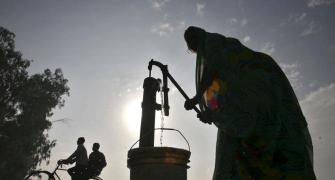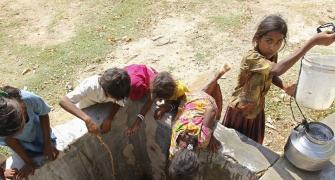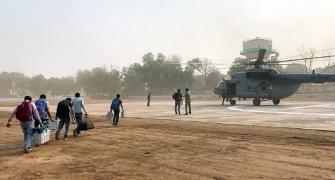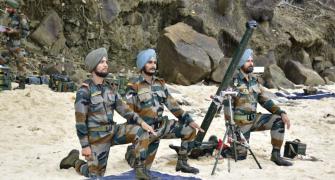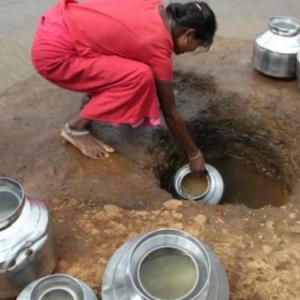A disruption in low salinity layer of water because of massive damming of rivers under the ILR and resultant reduction in fresh water flows into the sea, could have serious long-term consequences for climate and rainfall in the subcontinent, endangering the livelihoods of a vast population, says Mihir Shah.
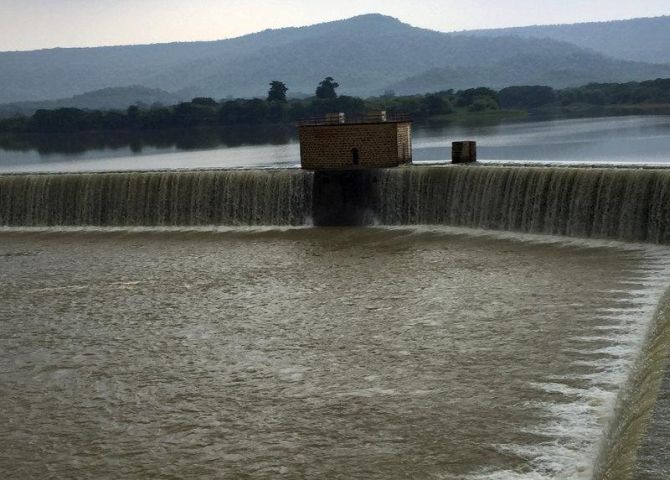
IMAGE: Gangau dam in Daudhan village in Madhya Pradesh. Photograph: Mayank Bhardwaj/Reuters
As the water crisis has deepened, so has our desperation and the extent we are prepared to go to violate the basic principles of both science and spirituality.
Instead of learning from our errors, we are tempted to go even further in the same mistaken direction.
The proposal for interlinking of India’s rivers (ILR) is based on a series of erroneous presumptions.
It is claimed that since some parts of India chronically have floods and others have droughts, the solution is to divert water from surplus river basins to deficit ones, so that everyone can live happily ever after!
Is it true that some areas in India have too much water?
Try telling the north-eastern states that!
Did you know that Sohra (previously known as Cherrapunjee), one of the highest rainfall hotspots on the planet, today suffers from an acute shortage of drinking water?
The reason for that lies precisely in the old paradigm of water management, where we have failed to protect our catchment areas, destroyed springs and over-exploited groundwater.
Climate change has aggravated the situation.
Today, my organisation, Samaj Pragati Sahayog, is working hard to find a solution to this vexed problem but I can tell you in Sohra, with only 70,000 people and as much as 8,000 mm of rain (10 times that of Delhi), we still have no water to spare for anyone else in the country!
In the sub-continent, given the dependence on the monsoon, the periods when rivers have “surplus” water are generally synchronous.
And a recent study finds a significant decrease in monsoon rainfall over water “surplus” river basins in India, thus raising questions about the basic presumptions of the ILR project.
It was a massive relief that the finance minister did not even make a mention of ILR in her Budget speech last month, hopefully an indicator of the clarity of thinking of the new Jal Shakti minister.
But given that the idea keeps popping up from time to time, and how dangerous it is, we must examine it carefully.
The Himalayan component of the ILR project plans to store water in dams on the Ganga and the Brahmaputra, in the supposedly surplus northern and eastern states and transfer that water via canals to the water-short central, southern and the western regions.
The Peninsular component attempts something similar on peninsular rivers, again transferring supposedly surplus water from the east to the south and west.
Overall, the attempt is to connect 44 rivers via 9,600 km of canals at an estimated cost of Rs 11 trillion.
This is only an approximation of the actual cost, which is likely to be much higher (given expected delays in implementation) and does not include costs of energy, farm and forest submergence and human displacement.
What is truly ironic is that, given the topography of India and the way the links are envisaged, they might totally bypass the core dryland areas of central and western India, which are located on elevations of 300 to 1,000 metres above mean sea level.
In recent years, scientists have begun to carefully examine the potential impact of such large interventions in India’s river systems.
A 2018 study of 29 of these 44 rivers published in the renowned international science journal Elementa finds that ILR will submerge 3,400 sqkm of land and displace approximately 700,000 people, other than the huge additional displacement that would be caused by the vast canal network.
It will also decrease river flows for 24 of the 29 rivers (as much as 73 per cent), reducing freshwater deliveries to wetlands and estuaries.
Waterways will be exposed to new contaminants, invasive species, and disease-causing agents and the already vulnerable deltas of the Indian subcontinent will be further compromised due to reduced silt deposited by rivers in their deltas by as much as 87 per cent.
Reduced stream-flows will likely affect delta salinity conditions and under a future rising sea-level scenario, the salinity of groundwater and river channels is expected to increase.
Climate-related salinity incursion in rivers and deltas will be exacerbated by the decrease in river mouth discharge.
Rare ecosystems and vital agricultural areas would become more vulnerable to storm surges, river flooding, and heightened salinity.
Already, reduced inflows due to natural and man-made processes have led to shoreline losses in the Krishna, Godavari and Mahanadi rivers.
The ILR will only aggravate the problem.
This scenario is very much in line with the past experience of the Colorado, Nile, Indus and Yellow (Huang He) river systems, where similar but actually smaller projects have been attempted in the past.
As the Elementa study argues, India’s ILR is “fifty to one-hundred times the volume of the largest inter-basin water transfer system in the United States and will likely constitute the largest construction project in human history”.
Finally, we must recognise that the ILR could profoundly impact the very integrity of India’s monsoon system.
The continuous flow of fresh river water into the sea is what helps maintain a low salinity layer of water with low density, in the upper layers of the Bay of Bengal.
This is a reason for the maintenance of high sea-surface temperatures (greater than 28 degrees Celsius), which create low-pressure areas and intensify monsoon activity.
Rainfall over much of the sub-continent is effectively controlled by this layer of low-salinity water.
A disruption in this layer because of massive damming of rivers under the ILR and resultant reduction in fresh water flows into the sea, could have serious long-term consequences for climate and rainfall in the subcontinent, endangering the livelihoods of a vast population.
Rivers are not human creations like roads and power lines, to be twisted and turned at will.
They are living ecosystems that have evolved over hundreds of thousands of years.
In our arrogance we have already caused them much damage.
It is time now for us to urgently come together to regenerate our river basin ecosystems, weaving our interventions into the delicate fabric of nature, with humility and wisdom, heeding both science and spirituality.
Mihir Shah is co-founder Samaj Pragati Sahayog.



